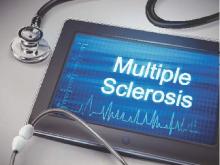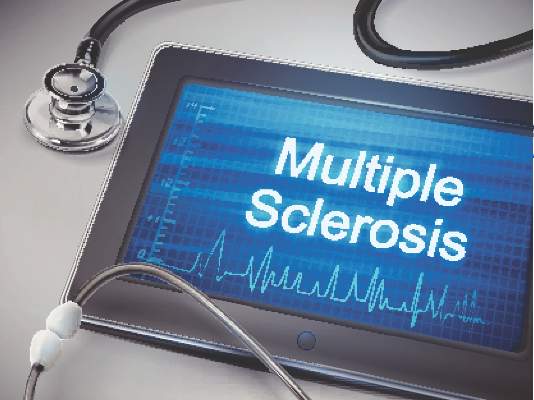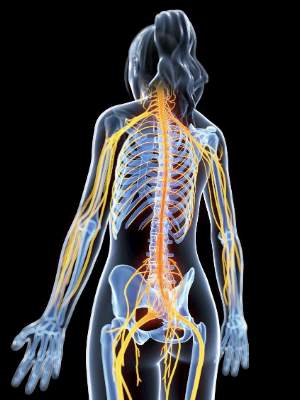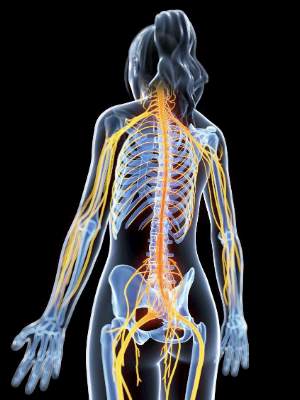User login
Real-world MS relapse rate is low for dimethyl fumarate
NATIONAL HARBOR, MD. – A real-world comparison of relapse rates in multiple sclerosis (MS) patients for five disease-modifying therapies (DMTs) found the largest decrease for delayed-release dimethyl fumarate (DMF) followed by fingolimod. Patients were less likely to adhere to treatment involving teriflunomide, glatiramer acetate, or interferon-beta (IFN-beta).
Real-world outcome data have been limited, so these findings from nearly 6,400 patients presented as a poster at the annual meeting of the Consortium of Multiple Sclerosis Centers will likely be important in guiding decisions on therapy in the management of MS.
“We need real-world data to better understand the behavior of these drugs in our real-world patients. We learn a tremendous amount from phase II and III clinical trials. We attempt to look at clinical trial results and then extrapolate to our real-world patient. However, by virtue of their design, clinical trial populations represent an incomplete MS demographic,” said Dr. Aaron Boster of Riverside Methodist Hospital, Columbus, Ohio.
The retrospective study collected claims data from Truven Health MarketScan databases between January 2012 and September 2014 for adults with MS who commenced DMT with an oral or injectable drug. Annualized relapse rates (ARRs) and DMT adherence were compared for teriflunomide (n = 500), fingolimod (n = 579), IFN-beta (n = 884), glatiramer acetate (n = 1,057), and DMF (n = 3,352).
The primary outcome was ARR, which was determined before and after initiation of DMT, based on the number of MS-related relapses before and in the year following initiation of therapy. Adherence to therapy was measured using the proportion of days covered within the first year after therapy began.
The DMF cohort had the largest reduction in unadjusted ARR, from 0.425 prior to therapy to 0.296 after therapy began (–0.129; P less than .0001), followed by those treated with fingolimod, from 0.442 prior to therapy to 0.307 following therapy (–0.135; P less than .001).
After researchers adjusted for baseline demographics, clinical characteristics, and prior DMT exposure, DMF was associated with significantly lower ARR than was glatiramer acetate, IFN-beta, and teriflunomide. DMF remained better than fingolimod, but the difference was not significant.
Relative to the DMF cohort, the adjusted incidence rate ratio of ARR in the year after DMT began was 1.34 (95% confidence interval, 1.17-1.53) for glatiramer acetate, 1.27 (95% CI, 1.10-1.46) for IFN-beta, 1.23 (95% CI, 1.05-1.45) for teriflunomide, and 1.03 (95% CI, 0.88-1.21) for fingolimod.
“Despite differences in patient demographics and comorbidities between DMT clinical trial populations and these U.S. claims data, the real-world effectiveness reported here is consistent with previous mixed and indirect treatment comparisons based on clinical trial data,” Dr. Boster and his colleagues said.
The implied differences in the real-world comparative effectiveness of the various DMTs should be considered when making decisions about the best therapy to manage MS, according to the researchers.
Dr. Boster disclosed research funding from Genentech, Actelion, and Mallinckrodt, and has received consulting/speaking remuneration from Genzyme, Novartis, Teva, Biogen, and Medtronic. The other researchers have received compensation from or are employees of Biogen.
NATIONAL HARBOR, MD. – A real-world comparison of relapse rates in multiple sclerosis (MS) patients for five disease-modifying therapies (DMTs) found the largest decrease for delayed-release dimethyl fumarate (DMF) followed by fingolimod. Patients were less likely to adhere to treatment involving teriflunomide, glatiramer acetate, or interferon-beta (IFN-beta).
Real-world outcome data have been limited, so these findings from nearly 6,400 patients presented as a poster at the annual meeting of the Consortium of Multiple Sclerosis Centers will likely be important in guiding decisions on therapy in the management of MS.
“We need real-world data to better understand the behavior of these drugs in our real-world patients. We learn a tremendous amount from phase II and III clinical trials. We attempt to look at clinical trial results and then extrapolate to our real-world patient. However, by virtue of their design, clinical trial populations represent an incomplete MS demographic,” said Dr. Aaron Boster of Riverside Methodist Hospital, Columbus, Ohio.
The retrospective study collected claims data from Truven Health MarketScan databases between January 2012 and September 2014 for adults with MS who commenced DMT with an oral or injectable drug. Annualized relapse rates (ARRs) and DMT adherence were compared for teriflunomide (n = 500), fingolimod (n = 579), IFN-beta (n = 884), glatiramer acetate (n = 1,057), and DMF (n = 3,352).
The primary outcome was ARR, which was determined before and after initiation of DMT, based on the number of MS-related relapses before and in the year following initiation of therapy. Adherence to therapy was measured using the proportion of days covered within the first year after therapy began.
The DMF cohort had the largest reduction in unadjusted ARR, from 0.425 prior to therapy to 0.296 after therapy began (–0.129; P less than .0001), followed by those treated with fingolimod, from 0.442 prior to therapy to 0.307 following therapy (–0.135; P less than .001).
After researchers adjusted for baseline demographics, clinical characteristics, and prior DMT exposure, DMF was associated with significantly lower ARR than was glatiramer acetate, IFN-beta, and teriflunomide. DMF remained better than fingolimod, but the difference was not significant.
Relative to the DMF cohort, the adjusted incidence rate ratio of ARR in the year after DMT began was 1.34 (95% confidence interval, 1.17-1.53) for glatiramer acetate, 1.27 (95% CI, 1.10-1.46) for IFN-beta, 1.23 (95% CI, 1.05-1.45) for teriflunomide, and 1.03 (95% CI, 0.88-1.21) for fingolimod.
“Despite differences in patient demographics and comorbidities between DMT clinical trial populations and these U.S. claims data, the real-world effectiveness reported here is consistent with previous mixed and indirect treatment comparisons based on clinical trial data,” Dr. Boster and his colleagues said.
The implied differences in the real-world comparative effectiveness of the various DMTs should be considered when making decisions about the best therapy to manage MS, according to the researchers.
Dr. Boster disclosed research funding from Genentech, Actelion, and Mallinckrodt, and has received consulting/speaking remuneration from Genzyme, Novartis, Teva, Biogen, and Medtronic. The other researchers have received compensation from or are employees of Biogen.
NATIONAL HARBOR, MD. – A real-world comparison of relapse rates in multiple sclerosis (MS) patients for five disease-modifying therapies (DMTs) found the largest decrease for delayed-release dimethyl fumarate (DMF) followed by fingolimod. Patients were less likely to adhere to treatment involving teriflunomide, glatiramer acetate, or interferon-beta (IFN-beta).
Real-world outcome data have been limited, so these findings from nearly 6,400 patients presented as a poster at the annual meeting of the Consortium of Multiple Sclerosis Centers will likely be important in guiding decisions on therapy in the management of MS.
“We need real-world data to better understand the behavior of these drugs in our real-world patients. We learn a tremendous amount from phase II and III clinical trials. We attempt to look at clinical trial results and then extrapolate to our real-world patient. However, by virtue of their design, clinical trial populations represent an incomplete MS demographic,” said Dr. Aaron Boster of Riverside Methodist Hospital, Columbus, Ohio.
The retrospective study collected claims data from Truven Health MarketScan databases between January 2012 and September 2014 for adults with MS who commenced DMT with an oral or injectable drug. Annualized relapse rates (ARRs) and DMT adherence were compared for teriflunomide (n = 500), fingolimod (n = 579), IFN-beta (n = 884), glatiramer acetate (n = 1,057), and DMF (n = 3,352).
The primary outcome was ARR, which was determined before and after initiation of DMT, based on the number of MS-related relapses before and in the year following initiation of therapy. Adherence to therapy was measured using the proportion of days covered within the first year after therapy began.
The DMF cohort had the largest reduction in unadjusted ARR, from 0.425 prior to therapy to 0.296 after therapy began (–0.129; P less than .0001), followed by those treated with fingolimod, from 0.442 prior to therapy to 0.307 following therapy (–0.135; P less than .001).
After researchers adjusted for baseline demographics, clinical characteristics, and prior DMT exposure, DMF was associated with significantly lower ARR than was glatiramer acetate, IFN-beta, and teriflunomide. DMF remained better than fingolimod, but the difference was not significant.
Relative to the DMF cohort, the adjusted incidence rate ratio of ARR in the year after DMT began was 1.34 (95% confidence interval, 1.17-1.53) for glatiramer acetate, 1.27 (95% CI, 1.10-1.46) for IFN-beta, 1.23 (95% CI, 1.05-1.45) for teriflunomide, and 1.03 (95% CI, 0.88-1.21) for fingolimod.
“Despite differences in patient demographics and comorbidities between DMT clinical trial populations and these U.S. claims data, the real-world effectiveness reported here is consistent with previous mixed and indirect treatment comparisons based on clinical trial data,” Dr. Boster and his colleagues said.
The implied differences in the real-world comparative effectiveness of the various DMTs should be considered when making decisions about the best therapy to manage MS, according to the researchers.
Dr. Boster disclosed research funding from Genentech, Actelion, and Mallinckrodt, and has received consulting/speaking remuneration from Genzyme, Novartis, Teva, Biogen, and Medtronic. The other researchers have received compensation from or are employees of Biogen.
AT THE CMSC ANNUAL MEETING
Key clinical point: Comparison of five disease-modifying therapies for MS has revealed the lowest relapse rate for dimethyl fumarate, which should help guide management decisions.
Major finding: Dimethyl fumarate treatment was associated with an unadjusted annualized relapse rate of –0.129, with fingolimod also having a significantly decreased relapse rate.
Data source: Data from claims databases involving nearly 6,400 MS patients.
Disclosures: The study was funded by Biogen. Dr. Boster disclosed research funding from Genentech, Actelion, and Mallinckrodt, and has received consulting/speaking remuneration from Genzyme, Novartis, Teva, Biogen, and Medtronic.
Alemtuzumab beneficial for MS patients of African descent
NATIONAL HARBOR, MD. – A subgroup analysis of 46 patients of African descent with active relapsing-remitting multiple sclerosis (RRMS) from the CARE-MS I and CARE-MS II trials has demonstrated the efficacy of alemtuzumab over 5 years.
The long-term results implicate alemtuzumab as a valuable treatment option for RRMS patients of African descent. These patients are at higher risk of more severe disease.
“In patients of African descent, alemtuzumab had clinical and [magnetic resonance imaging] efficacy comparable with that observed in the overall CARE-MS study population. Efficacy was durable over 5 years, with the majority of patients not receiving alemtuzumab treatment after month 12,” Dr. Annette Okai of the Multiple Sclerosis Treatment Center of Dallas reported at the annual meeting of the Consortium of Multiple Sclerosis Centers.
Patients of African descent have a heightened risk of MS that is more severe and more rapidly debilitating than that of white patients. As well, disease-modifying therapies may not be as effective in this group. To seek a better treatment option, Dr. Okai and colleagues performed a subgroup analysis involving the alemtuzumab treatment arm of the CARE I and II phase III randomized trials.
In CARE-MS I and II, a total of 811 patients received two annual intravenous injections of 12 mg alemtuzumab during the 2-year core phase of the trial and as-needed treatment during the extension phase from years 3 to 5. The trial cohort comprised 46 patients of African descent (80% from the United States, 76% female). Thirty-two of the 46 patients entered the extension phase.
Of the 32 patients, 17 (53%) did not receive retreatment beginning in year 2, and 28 (88%) did not receive another disease-modifying treatment. The efficacy of alemtuzumab in the overall CARE-MS cohort and in patients of African descent was durable over the full 5 years of the study. In those of African descent, the cumulative 0- to 5-year annualized relapse rate was 0.16. Sixty percent of the patients of African descent were relapse free in years 3-5.
Disease severity as measured by Expanded Disability Status Scale scores did not change appreciably over the 5 years (mean change, +0.52). No evidence of disease activity (NEDA) was observed in 33% of alemtuzumab patients in years 0-2, compared with 13% of those in the subcutaneous interferon beta-1a arm of CARE-MS I and II. Rates of NEDA in year 3, 4, and 5 were 45%, 42%, and 56%, respectively, and NEDA was achieved by 25% of the patients of African descent from years 3 to 5.
There were no serious infusion-associated reactions in the patients of African descent and the safety profile was similar to the overall cohort.
The efficacy and durability of alemtuzumab in the overall cohort generally, and in the patients of African descent more particularly, could reflect immunomodulation that is linked to lymphocyte repopulation, Dr. Okai suggested.
“Based on these findings, alemtuzumab may provide a unique treatment approach with durable efficacy in this high-risk population,” she concluded.
The studies were sponsored by Genzyme and Bayer Healthcare Pharmaceuticals. Dr. Okai disclosed receiving consulting fees from Genzyme, Novartis, Teva, Genentech, Biogen, and EMD Serono.
NATIONAL HARBOR, MD. – A subgroup analysis of 46 patients of African descent with active relapsing-remitting multiple sclerosis (RRMS) from the CARE-MS I and CARE-MS II trials has demonstrated the efficacy of alemtuzumab over 5 years.
The long-term results implicate alemtuzumab as a valuable treatment option for RRMS patients of African descent. These patients are at higher risk of more severe disease.
“In patients of African descent, alemtuzumab had clinical and [magnetic resonance imaging] efficacy comparable with that observed in the overall CARE-MS study population. Efficacy was durable over 5 years, with the majority of patients not receiving alemtuzumab treatment after month 12,” Dr. Annette Okai of the Multiple Sclerosis Treatment Center of Dallas reported at the annual meeting of the Consortium of Multiple Sclerosis Centers.
Patients of African descent have a heightened risk of MS that is more severe and more rapidly debilitating than that of white patients. As well, disease-modifying therapies may not be as effective in this group. To seek a better treatment option, Dr. Okai and colleagues performed a subgroup analysis involving the alemtuzumab treatment arm of the CARE I and II phase III randomized trials.
In CARE-MS I and II, a total of 811 patients received two annual intravenous injections of 12 mg alemtuzumab during the 2-year core phase of the trial and as-needed treatment during the extension phase from years 3 to 5. The trial cohort comprised 46 patients of African descent (80% from the United States, 76% female). Thirty-two of the 46 patients entered the extension phase.
Of the 32 patients, 17 (53%) did not receive retreatment beginning in year 2, and 28 (88%) did not receive another disease-modifying treatment. The efficacy of alemtuzumab in the overall CARE-MS cohort and in patients of African descent was durable over the full 5 years of the study. In those of African descent, the cumulative 0- to 5-year annualized relapse rate was 0.16. Sixty percent of the patients of African descent were relapse free in years 3-5.
Disease severity as measured by Expanded Disability Status Scale scores did not change appreciably over the 5 years (mean change, +0.52). No evidence of disease activity (NEDA) was observed in 33% of alemtuzumab patients in years 0-2, compared with 13% of those in the subcutaneous interferon beta-1a arm of CARE-MS I and II. Rates of NEDA in year 3, 4, and 5 were 45%, 42%, and 56%, respectively, and NEDA was achieved by 25% of the patients of African descent from years 3 to 5.
There were no serious infusion-associated reactions in the patients of African descent and the safety profile was similar to the overall cohort.
The efficacy and durability of alemtuzumab in the overall cohort generally, and in the patients of African descent more particularly, could reflect immunomodulation that is linked to lymphocyte repopulation, Dr. Okai suggested.
“Based on these findings, alemtuzumab may provide a unique treatment approach with durable efficacy in this high-risk population,” she concluded.
The studies were sponsored by Genzyme and Bayer Healthcare Pharmaceuticals. Dr. Okai disclosed receiving consulting fees from Genzyme, Novartis, Teva, Genentech, Biogen, and EMD Serono.
NATIONAL HARBOR, MD. – A subgroup analysis of 46 patients of African descent with active relapsing-remitting multiple sclerosis (RRMS) from the CARE-MS I and CARE-MS II trials has demonstrated the efficacy of alemtuzumab over 5 years.
The long-term results implicate alemtuzumab as a valuable treatment option for RRMS patients of African descent. These patients are at higher risk of more severe disease.
“In patients of African descent, alemtuzumab had clinical and [magnetic resonance imaging] efficacy comparable with that observed in the overall CARE-MS study population. Efficacy was durable over 5 years, with the majority of patients not receiving alemtuzumab treatment after month 12,” Dr. Annette Okai of the Multiple Sclerosis Treatment Center of Dallas reported at the annual meeting of the Consortium of Multiple Sclerosis Centers.
Patients of African descent have a heightened risk of MS that is more severe and more rapidly debilitating than that of white patients. As well, disease-modifying therapies may not be as effective in this group. To seek a better treatment option, Dr. Okai and colleagues performed a subgroup analysis involving the alemtuzumab treatment arm of the CARE I and II phase III randomized trials.
In CARE-MS I and II, a total of 811 patients received two annual intravenous injections of 12 mg alemtuzumab during the 2-year core phase of the trial and as-needed treatment during the extension phase from years 3 to 5. The trial cohort comprised 46 patients of African descent (80% from the United States, 76% female). Thirty-two of the 46 patients entered the extension phase.
Of the 32 patients, 17 (53%) did not receive retreatment beginning in year 2, and 28 (88%) did not receive another disease-modifying treatment. The efficacy of alemtuzumab in the overall CARE-MS cohort and in patients of African descent was durable over the full 5 years of the study. In those of African descent, the cumulative 0- to 5-year annualized relapse rate was 0.16. Sixty percent of the patients of African descent were relapse free in years 3-5.
Disease severity as measured by Expanded Disability Status Scale scores did not change appreciably over the 5 years (mean change, +0.52). No evidence of disease activity (NEDA) was observed in 33% of alemtuzumab patients in years 0-2, compared with 13% of those in the subcutaneous interferon beta-1a arm of CARE-MS I and II. Rates of NEDA in year 3, 4, and 5 were 45%, 42%, and 56%, respectively, and NEDA was achieved by 25% of the patients of African descent from years 3 to 5.
There were no serious infusion-associated reactions in the patients of African descent and the safety profile was similar to the overall cohort.
The efficacy and durability of alemtuzumab in the overall cohort generally, and in the patients of African descent more particularly, could reflect immunomodulation that is linked to lymphocyte repopulation, Dr. Okai suggested.
“Based on these findings, alemtuzumab may provide a unique treatment approach with durable efficacy in this high-risk population,” she concluded.
The studies were sponsored by Genzyme and Bayer Healthcare Pharmaceuticals. Dr. Okai disclosed receiving consulting fees from Genzyme, Novartis, Teva, Genentech, Biogen, and EMD Serono.
AT THE CMSC ANNUAL MEETING
Key clinical point: Alemtuzumab had clinical and radiologic benefits in patients of African descent with active RRMS.
Major finding: No evidence of disease activity was evident in 33% of patients of African descent treated with alemtuzumab in the first 2 years of treatment, compared with 13% of patients treated with subcutaneous interferon beta-1a.
Data source: Data from the CARE-MS I and CARE-MS II phase III randomized controlled trials.
Disclosures: The studies were sponsored by Genzyme and Bayer Healthcare Pharmaceuticals. Dr. Okai disclosed receiving consulting fees from Genzyme, Novartis, Teva, Genentech, Biogen, and EMD Serono.
Exercise Improves Sleep and May Improve Cognitive/Physical Function in MS
NATIONAL HARBOR, MD. – A pair of studies by the same research team has clarified how poor sleep worsens cognitive and physical function in people with multiple sclerosis (MS) and how poor sleep can be improved by exercise.
Whether the better sleep directly relates to the cognitive and physical improvements was not shown conclusively. However, a link between exercise and transient cognitive improvement has been demonstrated by others.
“Exercise may be a nonpharmacological and an inexpensive method to address sleep symptoms,” said Catherine Siengsukon, Ph.D., of the University of Kansas Medical Center, Kansas City, at the annual meeting of the Consortium of Multiple Sclerosis Centers.
About half of all people with MS experience poor sleep that results from the disease itself, medications, anxiety/depression, or other causes. The fatigue and reduced physical and psychological function diminish the quality of life and can increase the risk of mortality. “But it is unknown if poor sleep quality may impact physical function in individuals with MS,” said Dr. Siengsukon.
In healthy individuals, cognitive aspects like attention, working and long-term memory, information processing, decision making, and problem solving can all be affected by poor sleep. “But which cognitive domains are associated with poor sleep quality in people with MS is unknown,” said Dr. Siengsukon.
In the first study, 40 people (36 females) with MS (mainly relapsing-remitting MS) were analyzed through a battery of established tests of sleep quality, cognitive function, physical function, depression, anxiety, and quality of life. The subjects had a disease duration of about 12 years. All were ambulatory without the need of assistance, and none had sleep apnea.
About 68% of the subjects were considered poor sleepers with the remainder being good sleepers. They were comparable in age, sex, type of MS, disease duration, and cognitive impairment.
Compared with good sleepers, poor sleepers were significantly impaired in visuospatial memory and questionnaire-assessed physical function, were more fatigued, were more prone to be anxious and depressed, and had a worse quality of life. Independent factors of poor sleep quality included state and trait anxiety (P = .003 and .02, respectively).
“Evidence demonstrates that sleep consolidates memory. Therefore, poor sleep may selectively impair memory while not impacting other cognitive domains,” said Dr. Siengsukon.
In the second study, the influence of supervised, moderate exercise and home exercise on sleep quality was assessed in 22 other MS patients. Most had relapsing-remitting MS. The inclusion and exclusion criteria were similar to those for the first study, with additional exclusion criteria concerning cardiovascular risk of exercise.
The supervised stretching and exercise program for 12 subjects was done at a social center and utilized recumbent exercise machines, with the home-based program for 10 subjects consisting of stretching and outdoor walking. Both exercise programs were done three times weekly for 12 weeks.
Both exercise programs were beneficial in improving sleep, with the moderate-intensity program being relatively more effective than home-based exercise in two measurement scales of sleep. The greater benefit of moderate exercise might reflect the mode of exercise, with subjects feeling safer and more relaxed using a recumbent exerciser, Dr. Siengsukon said. Offering the exercise in a social setting might have been another plus.
“The results suggest that moderate-intensity exercise may improve cardiovascular fitness in people with MS. While both groups experienced moderate to large effects on sleep quality, the mechanism for improvement in sleep quality remains to be determined, as the improvement was not related to change in cardiorespiratory fitness,” said Dr. Siengsukon.
A link between treadmill exercise and transient cognitive improvement has been reported.
The studies were supported by the National Institutes of Health and the National Multiple Sclerosis Society. Dr. Siengsukon disclosed grant support from the National Multiple Sclerosis Society.
NATIONAL HARBOR, MD. – A pair of studies by the same research team has clarified how poor sleep worsens cognitive and physical function in people with multiple sclerosis (MS) and how poor sleep can be improved by exercise.
Whether the better sleep directly relates to the cognitive and physical improvements was not shown conclusively. However, a link between exercise and transient cognitive improvement has been demonstrated by others.
“Exercise may be a nonpharmacological and an inexpensive method to address sleep symptoms,” said Catherine Siengsukon, Ph.D., of the University of Kansas Medical Center, Kansas City, at the annual meeting of the Consortium of Multiple Sclerosis Centers.
About half of all people with MS experience poor sleep that results from the disease itself, medications, anxiety/depression, or other causes. The fatigue and reduced physical and psychological function diminish the quality of life and can increase the risk of mortality. “But it is unknown if poor sleep quality may impact physical function in individuals with MS,” said Dr. Siengsukon.
In healthy individuals, cognitive aspects like attention, working and long-term memory, information processing, decision making, and problem solving can all be affected by poor sleep. “But which cognitive domains are associated with poor sleep quality in people with MS is unknown,” said Dr. Siengsukon.
In the first study, 40 people (36 females) with MS (mainly relapsing-remitting MS) were analyzed through a battery of established tests of sleep quality, cognitive function, physical function, depression, anxiety, and quality of life. The subjects had a disease duration of about 12 years. All were ambulatory without the need of assistance, and none had sleep apnea.
About 68% of the subjects were considered poor sleepers with the remainder being good sleepers. They were comparable in age, sex, type of MS, disease duration, and cognitive impairment.
Compared with good sleepers, poor sleepers were significantly impaired in visuospatial memory and questionnaire-assessed physical function, were more fatigued, were more prone to be anxious and depressed, and had a worse quality of life. Independent factors of poor sleep quality included state and trait anxiety (P = .003 and .02, respectively).
“Evidence demonstrates that sleep consolidates memory. Therefore, poor sleep may selectively impair memory while not impacting other cognitive domains,” said Dr. Siengsukon.
In the second study, the influence of supervised, moderate exercise and home exercise on sleep quality was assessed in 22 other MS patients. Most had relapsing-remitting MS. The inclusion and exclusion criteria were similar to those for the first study, with additional exclusion criteria concerning cardiovascular risk of exercise.
The supervised stretching and exercise program for 12 subjects was done at a social center and utilized recumbent exercise machines, with the home-based program for 10 subjects consisting of stretching and outdoor walking. Both exercise programs were done three times weekly for 12 weeks.
Both exercise programs were beneficial in improving sleep, with the moderate-intensity program being relatively more effective than home-based exercise in two measurement scales of sleep. The greater benefit of moderate exercise might reflect the mode of exercise, with subjects feeling safer and more relaxed using a recumbent exerciser, Dr. Siengsukon said. Offering the exercise in a social setting might have been another plus.
“The results suggest that moderate-intensity exercise may improve cardiovascular fitness in people with MS. While both groups experienced moderate to large effects on sleep quality, the mechanism for improvement in sleep quality remains to be determined, as the improvement was not related to change in cardiorespiratory fitness,” said Dr. Siengsukon.
A link between treadmill exercise and transient cognitive improvement has been reported.
The studies were supported by the National Institutes of Health and the National Multiple Sclerosis Society. Dr. Siengsukon disclosed grant support from the National Multiple Sclerosis Society.
NATIONAL HARBOR, MD. – A pair of studies by the same research team has clarified how poor sleep worsens cognitive and physical function in people with multiple sclerosis (MS) and how poor sleep can be improved by exercise.
Whether the better sleep directly relates to the cognitive and physical improvements was not shown conclusively. However, a link between exercise and transient cognitive improvement has been demonstrated by others.
“Exercise may be a nonpharmacological and an inexpensive method to address sleep symptoms,” said Catherine Siengsukon, Ph.D., of the University of Kansas Medical Center, Kansas City, at the annual meeting of the Consortium of Multiple Sclerosis Centers.
About half of all people with MS experience poor sleep that results from the disease itself, medications, anxiety/depression, or other causes. The fatigue and reduced physical and psychological function diminish the quality of life and can increase the risk of mortality. “But it is unknown if poor sleep quality may impact physical function in individuals with MS,” said Dr. Siengsukon.
In healthy individuals, cognitive aspects like attention, working and long-term memory, information processing, decision making, and problem solving can all be affected by poor sleep. “But which cognitive domains are associated with poor sleep quality in people with MS is unknown,” said Dr. Siengsukon.
In the first study, 40 people (36 females) with MS (mainly relapsing-remitting MS) were analyzed through a battery of established tests of sleep quality, cognitive function, physical function, depression, anxiety, and quality of life. The subjects had a disease duration of about 12 years. All were ambulatory without the need of assistance, and none had sleep apnea.
About 68% of the subjects were considered poor sleepers with the remainder being good sleepers. They were comparable in age, sex, type of MS, disease duration, and cognitive impairment.
Compared with good sleepers, poor sleepers were significantly impaired in visuospatial memory and questionnaire-assessed physical function, were more fatigued, were more prone to be anxious and depressed, and had a worse quality of life. Independent factors of poor sleep quality included state and trait anxiety (P = .003 and .02, respectively).
“Evidence demonstrates that sleep consolidates memory. Therefore, poor sleep may selectively impair memory while not impacting other cognitive domains,” said Dr. Siengsukon.
In the second study, the influence of supervised, moderate exercise and home exercise on sleep quality was assessed in 22 other MS patients. Most had relapsing-remitting MS. The inclusion and exclusion criteria were similar to those for the first study, with additional exclusion criteria concerning cardiovascular risk of exercise.
The supervised stretching and exercise program for 12 subjects was done at a social center and utilized recumbent exercise machines, with the home-based program for 10 subjects consisting of stretching and outdoor walking. Both exercise programs were done three times weekly for 12 weeks.
Both exercise programs were beneficial in improving sleep, with the moderate-intensity program being relatively more effective than home-based exercise in two measurement scales of sleep. The greater benefit of moderate exercise might reflect the mode of exercise, with subjects feeling safer and more relaxed using a recumbent exerciser, Dr. Siengsukon said. Offering the exercise in a social setting might have been another plus.
“The results suggest that moderate-intensity exercise may improve cardiovascular fitness in people with MS. While both groups experienced moderate to large effects on sleep quality, the mechanism for improvement in sleep quality remains to be determined, as the improvement was not related to change in cardiorespiratory fitness,” said Dr. Siengsukon.
A link between treadmill exercise and transient cognitive improvement has been reported.
The studies were supported by the National Institutes of Health and the National Multiple Sclerosis Society. Dr. Siengsukon disclosed grant support from the National Multiple Sclerosis Society.
AT THE CMSC ANNUAL MEETING
Exercise improves sleep and may improve cognitive/physical function in MS
NATIONAL HARBOR, MD. – A pair of studies by the same research team has clarified how poor sleep worsens cognitive and physical function in people with multiple sclerosis (MS) and how poor sleep can be improved by exercise.
Whether the better sleep directly relates to the cognitive and physical improvements was not shown conclusively. However, a link between exercise and transient cognitive improvement has been demonstrated by others.
“Exercise may be a nonpharmacological and an inexpensive method to address sleep symptoms,” said Catherine Siengsukon, Ph.D., of the University of Kansas Medical Center, Kansas City, at the annual meeting of the Consortium of Multiple Sclerosis Centers.
About half of all people with MS experience poor sleep that results from the disease itself, medications, anxiety/depression, or other causes. The fatigue and reduced physical and psychological function diminish the quality of life and can increase the risk of mortality. “But it is unknown if poor sleep quality may impact physical function in individuals with MS,” said Dr. Siengsukon.
In healthy individuals, cognitive aspects like attention, working and long-term memory, information processing, decision making, and problem solving can all be affected by poor sleep. “But which cognitive domains are associated with poor sleep quality in people with MS is unknown,” said Dr. Siengsukon.
In the first study, 40 people (36 females) with MS (mainly relapsing-remitting MS) were analyzed through a battery of established tests of sleep quality, cognitive function, physical function, depression, anxiety, and quality of life. The subjects had a disease duration of about 12 years. All were ambulatory without the need of assistance, and none had sleep apnea.
About 68% of the subjects were considered poor sleepers with the remainder being good sleepers. They were comparable in age, sex, type of MS, disease duration, and cognitive impairment.
Compared with good sleepers, poor sleepers were significantly impaired in visuospatial memory and questionnaire-assessed physical function, were more fatigued, were more prone to be anxious and depressed, and had a worse quality of life. Independent factors of poor sleep quality included state and trait anxiety (P = .003 and .02, respectively).
“Evidence demonstrates that sleep consolidates memory. Therefore, poor sleep may selectively impair memory while not impacting other cognitive domains,” said Dr. Siengsukon.
In the second study, the influence of supervised, moderate exercise and home exercise on sleep quality was assessed in 22 other MS patients. Most had relapsing-remitting MS. The inclusion and exclusion criteria were similar to those for the first study, with additional exclusion criteria concerning cardiovascular risk of exercise.
The supervised stretching and exercise program for 12 subjects was done at a social center and utilized recumbent exercise machines, with the home-based program for 10 subjects consisting of stretching and outdoor walking. Both exercise programs were done three times weekly for 12 weeks.
Both exercise programs were beneficial in improving sleep, with the moderate-intensity program being relatively more effective than home-based exercise in two measurement scales of sleep. The greater benefit of moderate exercise might reflect the mode of exercise, with subjects feeling safer and more relaxed using a recumbent exerciser, Dr. Siengsukon said. Offering the exercise in a social setting might have been another plus.
“The results suggest that moderate-intensity exercise may improve cardiovascular fitness in people with MS. While both groups experienced moderate to large effects on sleep quality, the mechanism for improvement in sleep quality remains to be determined, as the improvement was not related to change in cardiorespiratory fitness,” said Dr. Siengsukon.
A link between treadmill exercise and transient cognitive improvement has been reported.
The studies were supported by the National Institutes of Health and the National Multiple Sclerosis Society. Dr. Siengsukon disclosed grant support from the National Multiple Sclerosis Society.
NATIONAL HARBOR, MD. – A pair of studies by the same research team has clarified how poor sleep worsens cognitive and physical function in people with multiple sclerosis (MS) and how poor sleep can be improved by exercise.
Whether the better sleep directly relates to the cognitive and physical improvements was not shown conclusively. However, a link between exercise and transient cognitive improvement has been demonstrated by others.
“Exercise may be a nonpharmacological and an inexpensive method to address sleep symptoms,” said Catherine Siengsukon, Ph.D., of the University of Kansas Medical Center, Kansas City, at the annual meeting of the Consortium of Multiple Sclerosis Centers.
About half of all people with MS experience poor sleep that results from the disease itself, medications, anxiety/depression, or other causes. The fatigue and reduced physical and psychological function diminish the quality of life and can increase the risk of mortality. “But it is unknown if poor sleep quality may impact physical function in individuals with MS,” said Dr. Siengsukon.
In healthy individuals, cognitive aspects like attention, working and long-term memory, information processing, decision making, and problem solving can all be affected by poor sleep. “But which cognitive domains are associated with poor sleep quality in people with MS is unknown,” said Dr. Siengsukon.
In the first study, 40 people (36 females) with MS (mainly relapsing-remitting MS) were analyzed through a battery of established tests of sleep quality, cognitive function, physical function, depression, anxiety, and quality of life. The subjects had a disease duration of about 12 years. All were ambulatory without the need of assistance, and none had sleep apnea.
About 68% of the subjects were considered poor sleepers with the remainder being good sleepers. They were comparable in age, sex, type of MS, disease duration, and cognitive impairment.
Compared with good sleepers, poor sleepers were significantly impaired in visuospatial memory and questionnaire-assessed physical function, were more fatigued, were more prone to be anxious and depressed, and had a worse quality of life. Independent factors of poor sleep quality included state and trait anxiety (P = .003 and .02, respectively).
“Evidence demonstrates that sleep consolidates memory. Therefore, poor sleep may selectively impair memory while not impacting other cognitive domains,” said Dr. Siengsukon.
In the second study, the influence of supervised, moderate exercise and home exercise on sleep quality was assessed in 22 other MS patients. Most had relapsing-remitting MS. The inclusion and exclusion criteria were similar to those for the first study, with additional exclusion criteria concerning cardiovascular risk of exercise.
The supervised stretching and exercise program for 12 subjects was done at a social center and utilized recumbent exercise machines, with the home-based program for 10 subjects consisting of stretching and outdoor walking. Both exercise programs were done three times weekly for 12 weeks.
Both exercise programs were beneficial in improving sleep, with the moderate-intensity program being relatively more effective than home-based exercise in two measurement scales of sleep. The greater benefit of moderate exercise might reflect the mode of exercise, with subjects feeling safer and more relaxed using a recumbent exerciser, Dr. Siengsukon said. Offering the exercise in a social setting might have been another plus.
“The results suggest that moderate-intensity exercise may improve cardiovascular fitness in people with MS. While both groups experienced moderate to large effects on sleep quality, the mechanism for improvement in sleep quality remains to be determined, as the improvement was not related to change in cardiorespiratory fitness,” said Dr. Siengsukon.
A link between treadmill exercise and transient cognitive improvement has been reported.
The studies were supported by the National Institutes of Health and the National Multiple Sclerosis Society. Dr. Siengsukon disclosed grant support from the National Multiple Sclerosis Society.
NATIONAL HARBOR, MD. – A pair of studies by the same research team has clarified how poor sleep worsens cognitive and physical function in people with multiple sclerosis (MS) and how poor sleep can be improved by exercise.
Whether the better sleep directly relates to the cognitive and physical improvements was not shown conclusively. However, a link between exercise and transient cognitive improvement has been demonstrated by others.
“Exercise may be a nonpharmacological and an inexpensive method to address sleep symptoms,” said Catherine Siengsukon, Ph.D., of the University of Kansas Medical Center, Kansas City, at the annual meeting of the Consortium of Multiple Sclerosis Centers.
About half of all people with MS experience poor sleep that results from the disease itself, medications, anxiety/depression, or other causes. The fatigue and reduced physical and psychological function diminish the quality of life and can increase the risk of mortality. “But it is unknown if poor sleep quality may impact physical function in individuals with MS,” said Dr. Siengsukon.
In healthy individuals, cognitive aspects like attention, working and long-term memory, information processing, decision making, and problem solving can all be affected by poor sleep. “But which cognitive domains are associated with poor sleep quality in people with MS is unknown,” said Dr. Siengsukon.
In the first study, 40 people (36 females) with MS (mainly relapsing-remitting MS) were analyzed through a battery of established tests of sleep quality, cognitive function, physical function, depression, anxiety, and quality of life. The subjects had a disease duration of about 12 years. All were ambulatory without the need of assistance, and none had sleep apnea.
About 68% of the subjects were considered poor sleepers with the remainder being good sleepers. They were comparable in age, sex, type of MS, disease duration, and cognitive impairment.
Compared with good sleepers, poor sleepers were significantly impaired in visuospatial memory and questionnaire-assessed physical function, were more fatigued, were more prone to be anxious and depressed, and had a worse quality of life. Independent factors of poor sleep quality included state and trait anxiety (P = .003 and .02, respectively).
“Evidence demonstrates that sleep consolidates memory. Therefore, poor sleep may selectively impair memory while not impacting other cognitive domains,” said Dr. Siengsukon.
In the second study, the influence of supervised, moderate exercise and home exercise on sleep quality was assessed in 22 other MS patients. Most had relapsing-remitting MS. The inclusion and exclusion criteria were similar to those for the first study, with additional exclusion criteria concerning cardiovascular risk of exercise.
The supervised stretching and exercise program for 12 subjects was done at a social center and utilized recumbent exercise machines, with the home-based program for 10 subjects consisting of stretching and outdoor walking. Both exercise programs were done three times weekly for 12 weeks.
Both exercise programs were beneficial in improving sleep, with the moderate-intensity program being relatively more effective than home-based exercise in two measurement scales of sleep. The greater benefit of moderate exercise might reflect the mode of exercise, with subjects feeling safer and more relaxed using a recumbent exerciser, Dr. Siengsukon said. Offering the exercise in a social setting might have been another plus.
“The results suggest that moderate-intensity exercise may improve cardiovascular fitness in people with MS. While both groups experienced moderate to large effects on sleep quality, the mechanism for improvement in sleep quality remains to be determined, as the improvement was not related to change in cardiorespiratory fitness,” said Dr. Siengsukon.
A link between treadmill exercise and transient cognitive improvement has been reported.
The studies were supported by the National Institutes of Health and the National Multiple Sclerosis Society. Dr. Siengsukon disclosed grant support from the National Multiple Sclerosis Society.
AT THE CMSC ANNUAL MEETING
Key clinical point: Moderate-intensity exercise may benefit MS patients in terms of improved sleep and perhaps improved cognitive and physical function.
Major finding: Exercise, especially a structured regimen of moderate exercise, improves sleep, and better-quality sleep improves visuospatial cognition and physical functioning in MS patients.
Data source: Two small exercise-intervention studies from the same research team.
Disclosures: Funded by the National Institutes of Health and the National Multiple Sclerosis Society. Dr. Siengsukon disclosed grant support from the National Multiple Sclerosis Society.
Oral contraceptive efficacy unaffected by dimethyl fumarate
NATIONAL HARBOR, MD. – Delayed-release dimethyl fumarate (DMF) coadministered with norgestimate/ethinyl estradiol, a commonly used progesterone-estrogen combination oral contraceptive, did not alter the OC’s pharmacokinetics or pharmacodynamics, according to the results of a small study.
The safety profile of the coadministered preparation is similar to the profile of DMF (Tecfidera, Biogen) alone, Dr. Bing Zhu said in a poster session at the annual meeting of the Consortium of Multiple Sclerosis Centers.
The findings indicate that women with relapsing-remitting multiple sclerosis (RRMS) who are of childbearing age and who are being treated with DMF can use OCs without having to modify the contraceptive dose, said Dr. Zhu, who is an employee of Biogen, Cambridge, Mass.
The study involved healthy women aged 18-45 years (mean age about 31 years) who were able to conceive. All received a daily OC (Ortho-Cyclen; 250 mcg norgestimate, 35 mcg ethinyl estradiol). After 28 days, those with progesterone levels less than 3 ng/mL were randomized to a 28-day regimen of either the daily dose of OC (n = 39) or OC along with DMF (240 mg twice daily), designated period 1, with crossover to the other treatment for a further 28 days (period 2). Blood samples were collected during the first 24 hours for pharmacokinetic measurements and at 2, 3, and 4 weeks for pharmacodynamic determinations.
The primary objective was the pharmacokinetics of norgestimate, as determined by measuring the levels of its main metabolite, norelgestromin. Secondary objectives included pharmacodynamics, as determined by the levels of serum progesterone and the safety/tolerability of DMF.
Plasma concentrations of norelgestromin and ethinyl estradiol were identical over time in the OC and OC + DMF groups in period 1, as was serum progesterone.
Treatment-emergent adverse events were similar in type and severity in both groups. Most were mild. The prevalent adverse events included flushing and gastrointestinal disorders accompanied by nausea and vomiting. Adverse events occurred in 10 of the 39 (26%) subjects who received the OC and in 26 of the 39 (67%) subjects who received the OC + DMF. Discontinuation because of adverse events occurred in 8% and 15% of subjects who received the OC and the OC + DMF, respectively. There were no deaths.
“The results suggest that women of childbearing potential treated with DMF are able to use a combined OC for contraception without dose modification,” said Dr. Zhu.
The study findings were recently published (Neurology. 2016 Apr 5;86:Suppl P2.097).
The study was funded by Biogen. Dr. Zhu is a Biogen employee.
NATIONAL HARBOR, MD. – Delayed-release dimethyl fumarate (DMF) coadministered with norgestimate/ethinyl estradiol, a commonly used progesterone-estrogen combination oral contraceptive, did not alter the OC’s pharmacokinetics or pharmacodynamics, according to the results of a small study.
The safety profile of the coadministered preparation is similar to the profile of DMF (Tecfidera, Biogen) alone, Dr. Bing Zhu said in a poster session at the annual meeting of the Consortium of Multiple Sclerosis Centers.
The findings indicate that women with relapsing-remitting multiple sclerosis (RRMS) who are of childbearing age and who are being treated with DMF can use OCs without having to modify the contraceptive dose, said Dr. Zhu, who is an employee of Biogen, Cambridge, Mass.
The study involved healthy women aged 18-45 years (mean age about 31 years) who were able to conceive. All received a daily OC (Ortho-Cyclen; 250 mcg norgestimate, 35 mcg ethinyl estradiol). After 28 days, those with progesterone levels less than 3 ng/mL were randomized to a 28-day regimen of either the daily dose of OC (n = 39) or OC along with DMF (240 mg twice daily), designated period 1, with crossover to the other treatment for a further 28 days (period 2). Blood samples were collected during the first 24 hours for pharmacokinetic measurements and at 2, 3, and 4 weeks for pharmacodynamic determinations.
The primary objective was the pharmacokinetics of norgestimate, as determined by measuring the levels of its main metabolite, norelgestromin. Secondary objectives included pharmacodynamics, as determined by the levels of serum progesterone and the safety/tolerability of DMF.
Plasma concentrations of norelgestromin and ethinyl estradiol were identical over time in the OC and OC + DMF groups in period 1, as was serum progesterone.
Treatment-emergent adverse events were similar in type and severity in both groups. Most were mild. The prevalent adverse events included flushing and gastrointestinal disorders accompanied by nausea and vomiting. Adverse events occurred in 10 of the 39 (26%) subjects who received the OC and in 26 of the 39 (67%) subjects who received the OC + DMF. Discontinuation because of adverse events occurred in 8% and 15% of subjects who received the OC and the OC + DMF, respectively. There were no deaths.
“The results suggest that women of childbearing potential treated with DMF are able to use a combined OC for contraception without dose modification,” said Dr. Zhu.
The study findings were recently published (Neurology. 2016 Apr 5;86:Suppl P2.097).
The study was funded by Biogen. Dr. Zhu is a Biogen employee.
NATIONAL HARBOR, MD. – Delayed-release dimethyl fumarate (DMF) coadministered with norgestimate/ethinyl estradiol, a commonly used progesterone-estrogen combination oral contraceptive, did not alter the OC’s pharmacokinetics or pharmacodynamics, according to the results of a small study.
The safety profile of the coadministered preparation is similar to the profile of DMF (Tecfidera, Biogen) alone, Dr. Bing Zhu said in a poster session at the annual meeting of the Consortium of Multiple Sclerosis Centers.
The findings indicate that women with relapsing-remitting multiple sclerosis (RRMS) who are of childbearing age and who are being treated with DMF can use OCs without having to modify the contraceptive dose, said Dr. Zhu, who is an employee of Biogen, Cambridge, Mass.
The study involved healthy women aged 18-45 years (mean age about 31 years) who were able to conceive. All received a daily OC (Ortho-Cyclen; 250 mcg norgestimate, 35 mcg ethinyl estradiol). After 28 days, those with progesterone levels less than 3 ng/mL were randomized to a 28-day regimen of either the daily dose of OC (n = 39) or OC along with DMF (240 mg twice daily), designated period 1, with crossover to the other treatment for a further 28 days (period 2). Blood samples were collected during the first 24 hours for pharmacokinetic measurements and at 2, 3, and 4 weeks for pharmacodynamic determinations.
The primary objective was the pharmacokinetics of norgestimate, as determined by measuring the levels of its main metabolite, norelgestromin. Secondary objectives included pharmacodynamics, as determined by the levels of serum progesterone and the safety/tolerability of DMF.
Plasma concentrations of norelgestromin and ethinyl estradiol were identical over time in the OC and OC + DMF groups in period 1, as was serum progesterone.
Treatment-emergent adverse events were similar in type and severity in both groups. Most were mild. The prevalent adverse events included flushing and gastrointestinal disorders accompanied by nausea and vomiting. Adverse events occurred in 10 of the 39 (26%) subjects who received the OC and in 26 of the 39 (67%) subjects who received the OC + DMF. Discontinuation because of adverse events occurred in 8% and 15% of subjects who received the OC and the OC + DMF, respectively. There were no deaths.
“The results suggest that women of childbearing potential treated with DMF are able to use a combined OC for contraception without dose modification,” said Dr. Zhu.
The study findings were recently published (Neurology. 2016 Apr 5;86:Suppl P2.097).
The study was funded by Biogen. Dr. Zhu is a Biogen employee.
AT THE CMSC ANNUAL MEETING
Key clinical point: Delayed-release dimethyl fumarate can be used in childbearing women with RRMS without fear of compromising the effect of a common oral contraceptive.
Major finding: DMF coadministered with a common oral contraceptive does not affect the pharmacokinetics and pharmacodynamics of the contraceptive.
Data source: Open-label, randomized, two-way crossover study involving 46 healthy women.
Disclosures: The study was funded by Biogen. Dr. Zhu is an employee of and stockholder in Biogen.
Teriflunomide effective for faster-advancing MS
NATIONAL HARBOR, MD. – The approved once-daily oral immunomodulator teriflunomide is effective in reducing relapse, and worsening of relapsing forms, of multiple sclerosis (RMS) in patients with faster-advancing disease.
The findings from a post hoc pooled subgroup analysis of patients in the TEMSO and TOWER randomized, double-blind, placebo-controlled phase III trials presented as a poster at the annual meeting of the Consortium of Multiple Sclerosis Centers expand the efficacy of teriflunomide to a broad spectrum of patients with RMS.
The pooled analysis examined the outcomes of treatment with two doses of teriflunomide in all patients (n = 2,257) and in a subgroup of patients with faster-advancing MS (n = 1,184) according to disease severity using a baseline Multiple Sclerosis Severity Score (MSSS) of 5 as a cutoff. The group with faster-advancing disease included 405 who received placebo, 396 treated with teriflunomide 7 mg, and 383 treated with teriflunomide 14 mg.
The 1,184 patients with faster-advancing MS were comparable to the other 1,073 patients in terms of age, sex, MS subtype, and number of relapses in the prior year. Baseline characteristics of the faster-advancing MS patients treated with placebo and both teriflunomide doses were comparable.
Relative to the placebo group, the annualized relapse rate in patients with faster-advancing MS was significantly reduced by both doses of teriflunomide, with a relative risk reduction of 30.3% for the 7-mg dose (P = .0002) and 37.5% for the 14-mg dose (P less than .0001). Time to first relapse was also reduced by teriflunomide 14 mg and 7 mg, with reductions in relapse risk of 43.2% (P less than .0001) and 28.8% (P = .0014), respectively, compared with placebo.
The higher dose of teriflunomide was effective in reducing the worsening of disability at greater than or equal to 12 weeks and 24 weeks, with reductions, compared with placebo, of 40.3% (P = .0076) and 46.1% (P = .0110), respectively.
The results were consistent with data reported in the individual TEMSO and TOWER trials, and prior analyses of the pooled data.
“These results indicate that teriflunomide is not only effective for MS patients with relatively mild disease, but also with rather more aggressive disease. Teriflunomide, a well-tolerated and convenient once-daily tablet, is a very reasonable option for this population,” said the presenter, Dr. Aaron E. Miller of the Icahn School of Medicine at Mount Sinai, New York.
Teriflunomide is approved for relapsing-remitting MS in many countries, including the United States and the European Union. The TEMSO and TOWER trials were pivotal in securing approval. The trials had a similar design, except for the absence of magnetic resonance imaging evaluation in TOWER.
The study was funded by Sanofi Genzyme. Dr. Miller disclosed consulting fees from Accordant Health Services, Acorda Therapeutics, Alkermes, Biogen, EMD Serono, Genentech, Genzyme, GlaxoSmithKline, Mallinckrodt Paharmaceuticals/Questor, Novartis, Roche, and Teva, and grant/research support from Biogen, Genentech, Novartis, Questor, Roche, and Sanofi.
NATIONAL HARBOR, MD. – The approved once-daily oral immunomodulator teriflunomide is effective in reducing relapse, and worsening of relapsing forms, of multiple sclerosis (RMS) in patients with faster-advancing disease.
The findings from a post hoc pooled subgroup analysis of patients in the TEMSO and TOWER randomized, double-blind, placebo-controlled phase III trials presented as a poster at the annual meeting of the Consortium of Multiple Sclerosis Centers expand the efficacy of teriflunomide to a broad spectrum of patients with RMS.
The pooled analysis examined the outcomes of treatment with two doses of teriflunomide in all patients (n = 2,257) and in a subgroup of patients with faster-advancing MS (n = 1,184) according to disease severity using a baseline Multiple Sclerosis Severity Score (MSSS) of 5 as a cutoff. The group with faster-advancing disease included 405 who received placebo, 396 treated with teriflunomide 7 mg, and 383 treated with teriflunomide 14 mg.
The 1,184 patients with faster-advancing MS were comparable to the other 1,073 patients in terms of age, sex, MS subtype, and number of relapses in the prior year. Baseline characteristics of the faster-advancing MS patients treated with placebo and both teriflunomide doses were comparable.
Relative to the placebo group, the annualized relapse rate in patients with faster-advancing MS was significantly reduced by both doses of teriflunomide, with a relative risk reduction of 30.3% for the 7-mg dose (P = .0002) and 37.5% for the 14-mg dose (P less than .0001). Time to first relapse was also reduced by teriflunomide 14 mg and 7 mg, with reductions in relapse risk of 43.2% (P less than .0001) and 28.8% (P = .0014), respectively, compared with placebo.
The higher dose of teriflunomide was effective in reducing the worsening of disability at greater than or equal to 12 weeks and 24 weeks, with reductions, compared with placebo, of 40.3% (P = .0076) and 46.1% (P = .0110), respectively.
The results were consistent with data reported in the individual TEMSO and TOWER trials, and prior analyses of the pooled data.
“These results indicate that teriflunomide is not only effective for MS patients with relatively mild disease, but also with rather more aggressive disease. Teriflunomide, a well-tolerated and convenient once-daily tablet, is a very reasonable option for this population,” said the presenter, Dr. Aaron E. Miller of the Icahn School of Medicine at Mount Sinai, New York.
Teriflunomide is approved for relapsing-remitting MS in many countries, including the United States and the European Union. The TEMSO and TOWER trials were pivotal in securing approval. The trials had a similar design, except for the absence of magnetic resonance imaging evaluation in TOWER.
The study was funded by Sanofi Genzyme. Dr. Miller disclosed consulting fees from Accordant Health Services, Acorda Therapeutics, Alkermes, Biogen, EMD Serono, Genentech, Genzyme, GlaxoSmithKline, Mallinckrodt Paharmaceuticals/Questor, Novartis, Roche, and Teva, and grant/research support from Biogen, Genentech, Novartis, Questor, Roche, and Sanofi.
NATIONAL HARBOR, MD. – The approved once-daily oral immunomodulator teriflunomide is effective in reducing relapse, and worsening of relapsing forms, of multiple sclerosis (RMS) in patients with faster-advancing disease.
The findings from a post hoc pooled subgroup analysis of patients in the TEMSO and TOWER randomized, double-blind, placebo-controlled phase III trials presented as a poster at the annual meeting of the Consortium of Multiple Sclerosis Centers expand the efficacy of teriflunomide to a broad spectrum of patients with RMS.
The pooled analysis examined the outcomes of treatment with two doses of teriflunomide in all patients (n = 2,257) and in a subgroup of patients with faster-advancing MS (n = 1,184) according to disease severity using a baseline Multiple Sclerosis Severity Score (MSSS) of 5 as a cutoff. The group with faster-advancing disease included 405 who received placebo, 396 treated with teriflunomide 7 mg, and 383 treated with teriflunomide 14 mg.
The 1,184 patients with faster-advancing MS were comparable to the other 1,073 patients in terms of age, sex, MS subtype, and number of relapses in the prior year. Baseline characteristics of the faster-advancing MS patients treated with placebo and both teriflunomide doses were comparable.
Relative to the placebo group, the annualized relapse rate in patients with faster-advancing MS was significantly reduced by both doses of teriflunomide, with a relative risk reduction of 30.3% for the 7-mg dose (P = .0002) and 37.5% for the 14-mg dose (P less than .0001). Time to first relapse was also reduced by teriflunomide 14 mg and 7 mg, with reductions in relapse risk of 43.2% (P less than .0001) and 28.8% (P = .0014), respectively, compared with placebo.
The higher dose of teriflunomide was effective in reducing the worsening of disability at greater than or equal to 12 weeks and 24 weeks, with reductions, compared with placebo, of 40.3% (P = .0076) and 46.1% (P = .0110), respectively.
The results were consistent with data reported in the individual TEMSO and TOWER trials, and prior analyses of the pooled data.
“These results indicate that teriflunomide is not only effective for MS patients with relatively mild disease, but also with rather more aggressive disease. Teriflunomide, a well-tolerated and convenient once-daily tablet, is a very reasonable option for this population,” said the presenter, Dr. Aaron E. Miller of the Icahn School of Medicine at Mount Sinai, New York.
Teriflunomide is approved for relapsing-remitting MS in many countries, including the United States and the European Union. The TEMSO and TOWER trials were pivotal in securing approval. The trials had a similar design, except for the absence of magnetic resonance imaging evaluation in TOWER.
The study was funded by Sanofi Genzyme. Dr. Miller disclosed consulting fees from Accordant Health Services, Acorda Therapeutics, Alkermes, Biogen, EMD Serono, Genentech, Genzyme, GlaxoSmithKline, Mallinckrodt Paharmaceuticals/Questor, Novartis, Roche, and Teva, and grant/research support from Biogen, Genentech, Novartis, Questor, Roche, and Sanofi.
AT THE CMSC ANNUAL MEETING
Key clinical point: Teriflunomide is effective for patients with faster-advancing MS.
Major finding: Teriflunomide at 14 mg and 7 mg reduced the annualized relapse rate of patients with fast-advancing relapsing-remitting MS (MSSS greater than 5) by 43.2% and 28.8%, respectively, compared with placebo.
Data source: A pooled analysis of patients from the TEMSO and TOWER randomized, double-blind, placebo-controlled phase III trials.
Disclosures: The study was funded by Sanofi Genzyme. Dr. Miller disclosed consulting fees from Accordant Health Services, Acorda Therapeutics, Alkermes, Biogen, EMD Serono, Genentech, Genzyme, GlaxoSmithKline, Mallinckrodt Paharmaceuticals/Questor, Novartis, Roche, and Teva, and grant/research support from Biogen, Genentech, Novartis, Questor, Roche, and Sanofi.
Smoking causes worse outcome in MS
NATIONAL HARBOR, MD. – Follow-up of a cohort of patients in the United Kingdom has demonstrated associations between smoking and a higher risk of development of multiple sclerosis (MS), progression of MS-related disability, higher risk of premature death, and shortened life expectancy.
The findings highlight the need for clinical trials of the effects of quitting smoking and provide data that will be useful in the development of effective intervention strategies.
Dr. Cris S. Constantinescu of the University of Nottingham (England) discussed findings from the Nottingham University Hospitals MS Clinics database at the annual meeting of the Consortium of Multiple Sclerosis Centers.
“Although smokers had higher levels of comorbid conditions, it appeared that the influence of smoking is independent of the presence of comorbid conditions. Those who gave up smoking could do as well as nonsmokers,” said Dr. Constantinescu.
While ample epidemiologic evidence indicates that smoking is a driver of the development and progression of MS, there are few hard data. To gain insight, the researchers analyzed data on over 1,200 MS patients throughout England who were followed up beginning in the mid-1990s. About 60% of the patients had relapsing-remitting MS. The duration of MS and smoking were both about 20 years. About 60% of men and 50% of women were current smokers.
Regular smokers were 64% more likely to develop MS than were nonsmokers. Having ever smoked carried a 44% increased risk of MS (both P less than .001). MS patients who grew up in a household where one parent smoked were 50% more likely to become regular smokers. The risk climbed to 85% if both parents were smokers.
No association was evident between smoking and the development of primary progressive MS, but current smokers were almost 2.5 times more likely to develop secondary progressive MS. Smoking correlated with more severe MS disability, compared with nonsmokers. Ex-smokers had risks similar to those of nonsmokers of developing secondary MS and in the level of disease severity.
Every year a person refrained from smoking decreased the risk of severe disability by 5%. Current and ex-smokers displayed increased psychological and physical detriments of MS.
In a subgroup of 923 patients, of whom 80 died, current smokers were almost 3 times and 1.5 times more likely to die, compared with never smokers and ex-smokers, respectively, and were twice as likely to die as were people without MS in the UK general population.
The findings have prompted studies into major aspects of smoking, such as the age when smoking begins, the success of various smoking cessation programs, and development of interventions. Some of the data discussed at the meeting were published in 2013 (Brain;136:2298-2304) and some are part of a manuscript in preparation.
NATIONAL HARBOR, MD. – Follow-up of a cohort of patients in the United Kingdom has demonstrated associations between smoking and a higher risk of development of multiple sclerosis (MS), progression of MS-related disability, higher risk of premature death, and shortened life expectancy.
The findings highlight the need for clinical trials of the effects of quitting smoking and provide data that will be useful in the development of effective intervention strategies.
Dr. Cris S. Constantinescu of the University of Nottingham (England) discussed findings from the Nottingham University Hospitals MS Clinics database at the annual meeting of the Consortium of Multiple Sclerosis Centers.
“Although smokers had higher levels of comorbid conditions, it appeared that the influence of smoking is independent of the presence of comorbid conditions. Those who gave up smoking could do as well as nonsmokers,” said Dr. Constantinescu.
While ample epidemiologic evidence indicates that smoking is a driver of the development and progression of MS, there are few hard data. To gain insight, the researchers analyzed data on over 1,200 MS patients throughout England who were followed up beginning in the mid-1990s. About 60% of the patients had relapsing-remitting MS. The duration of MS and smoking were both about 20 years. About 60% of men and 50% of women were current smokers.
Regular smokers were 64% more likely to develop MS than were nonsmokers. Having ever smoked carried a 44% increased risk of MS (both P less than .001). MS patients who grew up in a household where one parent smoked were 50% more likely to become regular smokers. The risk climbed to 85% if both parents were smokers.
No association was evident between smoking and the development of primary progressive MS, but current smokers were almost 2.5 times more likely to develop secondary progressive MS. Smoking correlated with more severe MS disability, compared with nonsmokers. Ex-smokers had risks similar to those of nonsmokers of developing secondary MS and in the level of disease severity.
Every year a person refrained from smoking decreased the risk of severe disability by 5%. Current and ex-smokers displayed increased psychological and physical detriments of MS.
In a subgroup of 923 patients, of whom 80 died, current smokers were almost 3 times and 1.5 times more likely to die, compared with never smokers and ex-smokers, respectively, and were twice as likely to die as were people without MS in the UK general population.
The findings have prompted studies into major aspects of smoking, such as the age when smoking begins, the success of various smoking cessation programs, and development of interventions. Some of the data discussed at the meeting were published in 2013 (Brain;136:2298-2304) and some are part of a manuscript in preparation.
NATIONAL HARBOR, MD. – Follow-up of a cohort of patients in the United Kingdom has demonstrated associations between smoking and a higher risk of development of multiple sclerosis (MS), progression of MS-related disability, higher risk of premature death, and shortened life expectancy.
The findings highlight the need for clinical trials of the effects of quitting smoking and provide data that will be useful in the development of effective intervention strategies.
Dr. Cris S. Constantinescu of the University of Nottingham (England) discussed findings from the Nottingham University Hospitals MS Clinics database at the annual meeting of the Consortium of Multiple Sclerosis Centers.
“Although smokers had higher levels of comorbid conditions, it appeared that the influence of smoking is independent of the presence of comorbid conditions. Those who gave up smoking could do as well as nonsmokers,” said Dr. Constantinescu.
While ample epidemiologic evidence indicates that smoking is a driver of the development and progression of MS, there are few hard data. To gain insight, the researchers analyzed data on over 1,200 MS patients throughout England who were followed up beginning in the mid-1990s. About 60% of the patients had relapsing-remitting MS. The duration of MS and smoking were both about 20 years. About 60% of men and 50% of women were current smokers.
Regular smokers were 64% more likely to develop MS than were nonsmokers. Having ever smoked carried a 44% increased risk of MS (both P less than .001). MS patients who grew up in a household where one parent smoked were 50% more likely to become regular smokers. The risk climbed to 85% if both parents were smokers.
No association was evident between smoking and the development of primary progressive MS, but current smokers were almost 2.5 times more likely to develop secondary progressive MS. Smoking correlated with more severe MS disability, compared with nonsmokers. Ex-smokers had risks similar to those of nonsmokers of developing secondary MS and in the level of disease severity.
Every year a person refrained from smoking decreased the risk of severe disability by 5%. Current and ex-smokers displayed increased psychological and physical detriments of MS.
In a subgroup of 923 patients, of whom 80 died, current smokers were almost 3 times and 1.5 times more likely to die, compared with never smokers and ex-smokers, respectively, and were twice as likely to die as were people without MS in the UK general population.
The findings have prompted studies into major aspects of smoking, such as the age when smoking begins, the success of various smoking cessation programs, and development of interventions. Some of the data discussed at the meeting were published in 2013 (Brain;136:2298-2304) and some are part of a manuscript in preparation.
AT THE CMSC ANNUAL MEETING
Key clinical point: Smoking increases the risk of developing multiple sclerosis and worsens the severity of the disease.
Major finding: Regular smokers are 64% more likely to develop MS than are nonsmokers.
Data source: Nottingham MS Clinic Study.
Disclosures: Dr. Constantinescu reported having no financial disclosures.
MS imaging guidelines from North American group offer standardized protocols
NATIONAL HARBOR, MD. – Updated imaging protocols for patients with multiple sclerosis from a panel of North American neurology and radiology experts promise to improve the accuracy of diagnosis and monitoring.
The guidelines emphasize the use of three-dimensional MRI to provide complete coverage of the brain, monitoring for progressive multifocal leukoencephalopathy (PML), and optical orbit MRI for severe optic neuritis.
Key clinical guideline changes include more specific timing of brain MRI when monitoring patients receiving disease modifying therapy, timing of brain MRI to monitor for PML, updated evidence of the value of MRI changes in determining the effectiveness of treatment, and the inclusion of radiologic isolated syndrome.
Dr. Anthony Traboulsee of the University of British Columbia, Vancouver, discussed the latest MRI guidelines at the annual meeting of the Consortium of Multiple Sclerosis Centers.
“MS is a life-long disorder and MRI is one of the best ways to monitor for new lesions that can be occurring in the absence of new symptoms (clinically silent disease activity). These lesions accumulate and lead to future disability. In order to accurately determine if changes are occurring, we need MRIs that are similar in quality over time regardless of where the patient had an MRI performed. A standardized MRI protocol provides this quality of data,” Dr. Traboulsee said.
The guidelines, published in the American Journal of Neuroradiology (Am J Neuroradiol. 2015 Nov 12. doi: 10.3174/ajnr.A4539), recommend a first MRI as soon as a physician suspects MS in a patient, with subsequent MRIs typically done annually to determine whether the disease is stable or progressive, which could prompt a change in treatment. “Breakthrough activity on MRI that is occurring while on treatment can lead to future disability and is an opportunity to consider switching therapy,” Dr. Traboulsee said.
More frequent scans could be appropriate for patients with a more aggressive and active disease course, and when treatment has been changed. More frequent monitoring and diffusion-weighted imaging is also recommended for patients taking natalizumab (Tysabri), since they are at high risk for PML.
Another goal of the guidelines is to describe how best to use MRI to support an early diagnosis of MS and to help avoid misdiagnosis. Early treatment depends on an early diagnosis. “We find the biggest impact of our disease-modifying therapy is in the first decade. The goal is to prevent new injury and optimize brain health through treatment and lifestyle,” said Dr. Traboulsee.
MRI scans alone should not be diagnostic. Clinical information is also needed, such as numbness or problems with balance. Abnormal brain MRIs occur in about 5% of people without MS and white spots in the brain that are unrelated to MS can naturally develop as people age.
If clinically isolated syndrome is suspected, a cervical cord MRI should be done along with a brain MRI. Use of a gadolinium contrast agent is recommended to better determine disease activity and speed diagnosis.
Dr. Traboulsee received grant support from Biogen, Chugai, Hoffman la Roche, and Sanofi Genzyme. He reported being a steering committee member for Hoffman la Roche and has been a consultant to Biogen, Chugai, EMD Serono, Hoffman la Roche, MedImmune, Sanofi Genzyme, and Teva Neuroscience.
NATIONAL HARBOR, MD. – Updated imaging protocols for patients with multiple sclerosis from a panel of North American neurology and radiology experts promise to improve the accuracy of diagnosis and monitoring.
The guidelines emphasize the use of three-dimensional MRI to provide complete coverage of the brain, monitoring for progressive multifocal leukoencephalopathy (PML), and optical orbit MRI for severe optic neuritis.
Key clinical guideline changes include more specific timing of brain MRI when monitoring patients receiving disease modifying therapy, timing of brain MRI to monitor for PML, updated evidence of the value of MRI changes in determining the effectiveness of treatment, and the inclusion of radiologic isolated syndrome.
Dr. Anthony Traboulsee of the University of British Columbia, Vancouver, discussed the latest MRI guidelines at the annual meeting of the Consortium of Multiple Sclerosis Centers.
“MS is a life-long disorder and MRI is one of the best ways to monitor for new lesions that can be occurring in the absence of new symptoms (clinically silent disease activity). These lesions accumulate and lead to future disability. In order to accurately determine if changes are occurring, we need MRIs that are similar in quality over time regardless of where the patient had an MRI performed. A standardized MRI protocol provides this quality of data,” Dr. Traboulsee said.
The guidelines, published in the American Journal of Neuroradiology (Am J Neuroradiol. 2015 Nov 12. doi: 10.3174/ajnr.A4539), recommend a first MRI as soon as a physician suspects MS in a patient, with subsequent MRIs typically done annually to determine whether the disease is stable or progressive, which could prompt a change in treatment. “Breakthrough activity on MRI that is occurring while on treatment can lead to future disability and is an opportunity to consider switching therapy,” Dr. Traboulsee said.
More frequent scans could be appropriate for patients with a more aggressive and active disease course, and when treatment has been changed. More frequent monitoring and diffusion-weighted imaging is also recommended for patients taking natalizumab (Tysabri), since they are at high risk for PML.
Another goal of the guidelines is to describe how best to use MRI to support an early diagnosis of MS and to help avoid misdiagnosis. Early treatment depends on an early diagnosis. “We find the biggest impact of our disease-modifying therapy is in the first decade. The goal is to prevent new injury and optimize brain health through treatment and lifestyle,” said Dr. Traboulsee.
MRI scans alone should not be diagnostic. Clinical information is also needed, such as numbness or problems with balance. Abnormal brain MRIs occur in about 5% of people without MS and white spots in the brain that are unrelated to MS can naturally develop as people age.
If clinically isolated syndrome is suspected, a cervical cord MRI should be done along with a brain MRI. Use of a gadolinium contrast agent is recommended to better determine disease activity and speed diagnosis.
Dr. Traboulsee received grant support from Biogen, Chugai, Hoffman la Roche, and Sanofi Genzyme. He reported being a steering committee member for Hoffman la Roche and has been a consultant to Biogen, Chugai, EMD Serono, Hoffman la Roche, MedImmune, Sanofi Genzyme, and Teva Neuroscience.
NATIONAL HARBOR, MD. – Updated imaging protocols for patients with multiple sclerosis from a panel of North American neurology and radiology experts promise to improve the accuracy of diagnosis and monitoring.
The guidelines emphasize the use of three-dimensional MRI to provide complete coverage of the brain, monitoring for progressive multifocal leukoencephalopathy (PML), and optical orbit MRI for severe optic neuritis.
Key clinical guideline changes include more specific timing of brain MRI when monitoring patients receiving disease modifying therapy, timing of brain MRI to monitor for PML, updated evidence of the value of MRI changes in determining the effectiveness of treatment, and the inclusion of radiologic isolated syndrome.
Dr. Anthony Traboulsee of the University of British Columbia, Vancouver, discussed the latest MRI guidelines at the annual meeting of the Consortium of Multiple Sclerosis Centers.
“MS is a life-long disorder and MRI is one of the best ways to monitor for new lesions that can be occurring in the absence of new symptoms (clinically silent disease activity). These lesions accumulate and lead to future disability. In order to accurately determine if changes are occurring, we need MRIs that are similar in quality over time regardless of where the patient had an MRI performed. A standardized MRI protocol provides this quality of data,” Dr. Traboulsee said.
The guidelines, published in the American Journal of Neuroradiology (Am J Neuroradiol. 2015 Nov 12. doi: 10.3174/ajnr.A4539), recommend a first MRI as soon as a physician suspects MS in a patient, with subsequent MRIs typically done annually to determine whether the disease is stable or progressive, which could prompt a change in treatment. “Breakthrough activity on MRI that is occurring while on treatment can lead to future disability and is an opportunity to consider switching therapy,” Dr. Traboulsee said.
More frequent scans could be appropriate for patients with a more aggressive and active disease course, and when treatment has been changed. More frequent monitoring and diffusion-weighted imaging is also recommended for patients taking natalizumab (Tysabri), since they are at high risk for PML.
Another goal of the guidelines is to describe how best to use MRI to support an early diagnosis of MS and to help avoid misdiagnosis. Early treatment depends on an early diagnosis. “We find the biggest impact of our disease-modifying therapy is in the first decade. The goal is to prevent new injury and optimize brain health through treatment and lifestyle,” said Dr. Traboulsee.
MRI scans alone should not be diagnostic. Clinical information is also needed, such as numbness or problems with balance. Abnormal brain MRIs occur in about 5% of people without MS and white spots in the brain that are unrelated to MS can naturally develop as people age.
If clinically isolated syndrome is suspected, a cervical cord MRI should be done along with a brain MRI. Use of a gadolinium contrast agent is recommended to better determine disease activity and speed diagnosis.
Dr. Traboulsee received grant support from Biogen, Chugai, Hoffman la Roche, and Sanofi Genzyme. He reported being a steering committee member for Hoffman la Roche and has been a consultant to Biogen, Chugai, EMD Serono, Hoffman la Roche, MedImmune, Sanofi Genzyme, and Teva Neuroscience.
AT THE CMSC ANNUAL MEETING
















